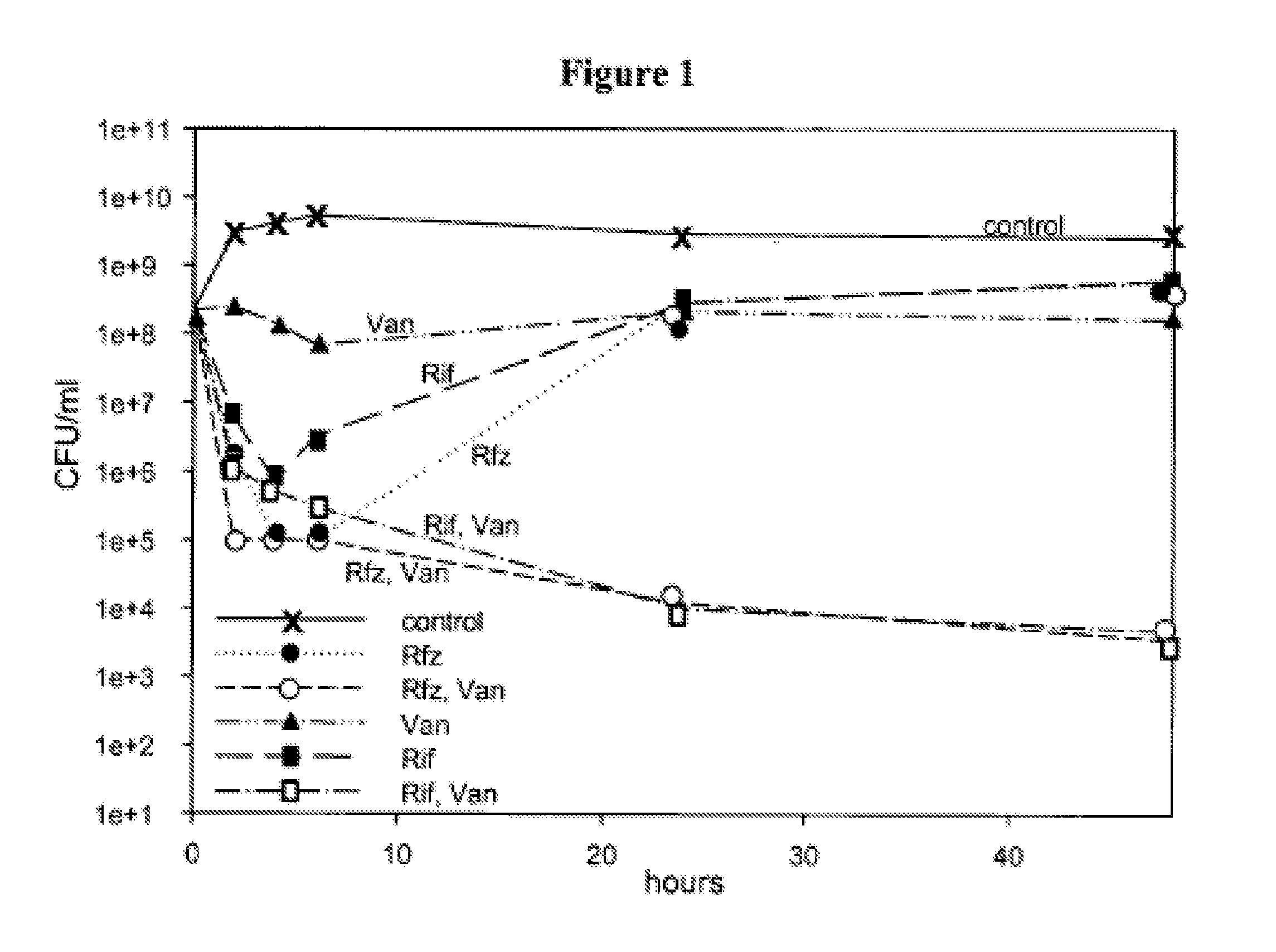Methods and compositions for treating bacterial infections and diseases associated therewith
a technology for applied in the field of methods and compositions for treating bacterial infections and diseases associated therewith, can solve the problems of recurrence, resistance, and antimicrobial resistance, and achieve the effects of preventing recurrence, preventing recurrence, and preventing recurren
- Summary
- Abstract
- Description
- Claims
- Application Information
AI Technical Summary
Benefits of technology
Problems solved by technology
Method used
Image
Examples
example 1
Treatment of Log-Phase S. aureus Cultures with Rif, Rfz and Van
[0082]Replicate log-phase cultures of S. aureus 29213 were exposed to Rif, Rfz, Van, Rif+Van, or Rfz+Van. Viability of the cultures was monitored by plating aliquots of the cultures on non-selective MHA plates times 0, 2, 4, 6, 24 and 48 hours as described herein (FIG. 1). Rif and Rfz were used at a concentration of 0.1 μg / ml, approximately 6.5× their MIC(Rif and Rfz MIC values are each 0.015 μg / ml; these MIC values were determined according to NCCLS standard MIC testing; National Committee for Clinical Laboratory Standards. 1997. Methods for Dilution Antimicrobial Susceptibility Tests for Bacteria That Grow Aerobically-Fourth Edition Approved Standard M7-A4. NCCLS, Villanova, Pa.). Van was used at 10 μg / ml, corresponding to 10× its MIC for the S. aureus strain.
[0083]In this experiment, Rfz alone caused a fairly rapid drop in cfu / ml, with approximately 3.5 logs killed in 4 hours. After a 24-hour period, however, the viab...
example 2
Treatment of Log-Phase S. aureus Cultures with Rfz Alone or in Combination with Van
[0086]Replicate log-phase cultures of S. aureus were treated with Rfz at 0.1 μg / ml or 0.025 μg / ml alone or in combination with Van at 15 μg / ml and monitored for cfu / ml at 4.5 hours, 24 hours and 48 hours (FIG. 3). The two levels of Rfz used in this experiment are equal to 6.5× and 1.6× the MIC of Rfz. At 6.5× its MIC, Rfz was effective at reducing the cfu / ml of the culture by approximately 3 logs within 6 hours (cidality). At the lower concentration, Rfz was just as effective at reducing cfu / ml of the culture as when it was used at the higher concentration. As we observed previously, the cfu / ml levels in these cultures increased over 48 hours to approximately 1×108 cfu / ml. In combination with Van, both concentrations of Rfz were able to decrease (at 4.5 hours) cfu / ml of the cultures more effectively than Rfz used alone (about ½ log greater effect). The combination-treated cultures did not exhibit exte...
example 3
Treatment of Stationary-Phase S. aureus Cultures with Rfz and Van
[0088]Cultures of S. aureus 29213 were grown to stationary-phase (an OD of 2.2 to 2.4 at 600 nm), then treated with Van and Rfz, either alone or in combination (FIG. 5; concentrations listed are in μg / ml). Rfz was used at 0.1 μg / ml, while Van was used at 15 μg / ml and 30 μg / ml, the latter concentration based on the fact that the starting culture was at a much higher density than was the log-phase cultures used in the experiments described above. It was assumed that more Van might be required to give a prolonged killing effect. In addition, one culture was treated with 15 μg / ml Van (Van15×2) at the start of the experiment and then again 24 hours later. At 0, 24 and 48 hours, the number of viable cells was determined by plating on non-selective medium as described above. The results are shown in FIG. 5.
[0089]The viability of the cultures did not decrease significantly during treatment with Van at either concentration used...
PUM
| Property | Measurement | Unit |
|---|---|---|
| time | aaaaa | aaaaa |
| concentration | aaaaa | aaaaa |
| concentration | aaaaa | aaaaa |
Abstract
Description
Claims
Application Information
 Login to View More
Login to View More - R&D
- Intellectual Property
- Life Sciences
- Materials
- Tech Scout
- Unparalleled Data Quality
- Higher Quality Content
- 60% Fewer Hallucinations
Browse by: Latest US Patents, China's latest patents, Technical Efficacy Thesaurus, Application Domain, Technology Topic, Popular Technical Reports.
© 2025 PatSnap. All rights reserved.Legal|Privacy policy|Modern Slavery Act Transparency Statement|Sitemap|About US| Contact US: help@patsnap.com



